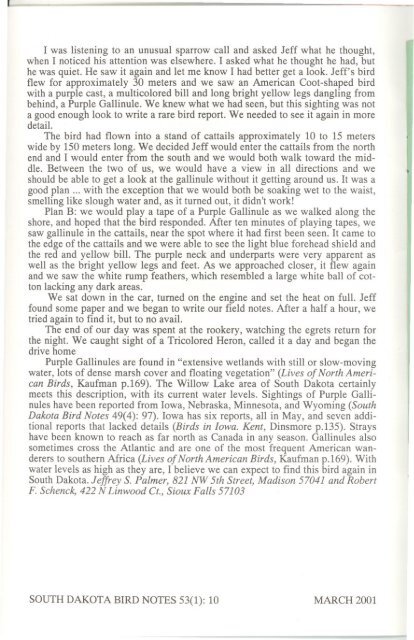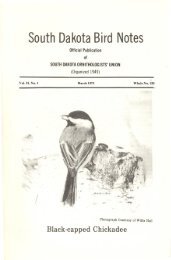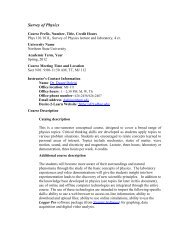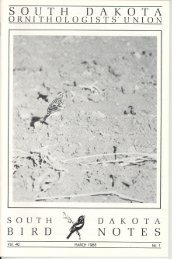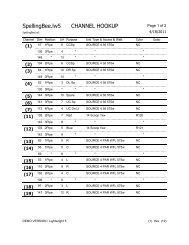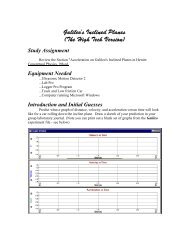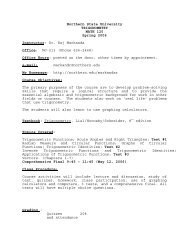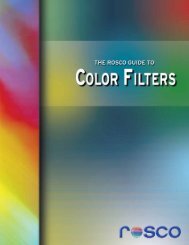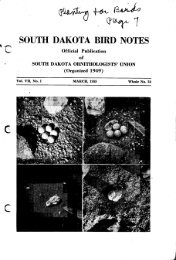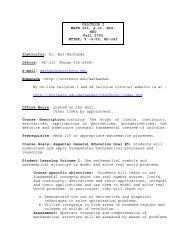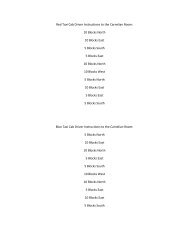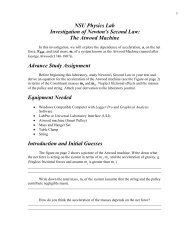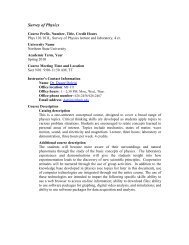I was listening to an unusual sparrow call and asked Jeff what he thought,when I noticed his attention was elsewhere. I asked what he thought he had, buthe was quiet. He saw it again and let me know I had better get a look. Jeff's birdflew for approximately 30 meters and we saw an American Coot-shaped birdwith a purple cast, a multicolored bill and long bright yellow legs dangling frombehind, a Purple Gallinule. We knew what we had seen, but this sighting was nota good enough look to write a rare bird report. We needed to see it again in moredetail.The bird had flown into a stand of cattails approximately 10 to 15 meterswide by 150 meters long. We decided Jeff would enter the cattails from the northend and I would enter from the south and we would both walk toward the middle.Between the two of us, we would have a view in all directions and weshould be able to get a look at the gallinule without it getting around us. It was agood plan ... with the exception that we would both be soaking wet to the waist,smelling like slough water and, as it turned out, it didn't work!Plan B: we would playa tape of a Purple Gallinule as we walked along theshore, and hoped that the bird responded. Mer ten minutes of playing tapes, wesaw gallinule in the cattails, near the spot where it had first been seen. It came tothe edge of the cattails and we were able to see the light blue forehead shield andthe red and yellow bill. The purple neck and underparts were very apparent aswell as the bright yellow legs and feet. As we approached closer, it flew againand we saw the white rump feathers, which resembled a large white ball of cottonlacking any dark areas.We sat down in the car, turned on the engine and set the heat on full. Jefffound some paper and we began to write our field notes. Mter a half a hour, wetried again to find it, but to no avail.The end of our day was spent at the rookery, watching the egrets return forthe night. We caught sight of a Tricolored Heron, called it a day and began thedrive homePurple Gallinules are found in "extensive wetlands with still or slow-movingwater, lots of dense marsh cover and floating vegetation" (Lives of North AmericanBirds, Kaufman p.169). The Willow Lake area of South Dakota certainlymeets this description, with its current water levels. Sightings of Purple Gallinuleshave been reported from Iowa, Nebraska, Minnesota, and Wyoming (SouthDakota Bird Notes 49(4): 97). Iowa has six reports, all in May, and seven additionalreports that lacked details (Birds in Iowa. Kent, Dinsmore p.135). Strayshave been known to reach as far north as Canada in any season. Gallinules alsosometimes cross the Atlantic and are one of the most frequent American wanderersto southern Mrica (Lives of North American Birds, Kaufman p.169). Withwater levels as high as they are, I believe we can expect to find this bird again inSouth Dakota. Jeffrey S. Palmer, 821 NW 5th Street, Madison 57041 and RobertF. Schenck, 422 N Linwood Ct., Sioux Falls 57103SOUTH DAKOTA BIRD NOTES <strong>53</strong>(1): 10 MARCH <strong>2001</strong>
~WISCONSIN'S FAVORITE BIRD HAUNTS. 2000. Daryl D. Tessen. TheWisconsin Society for Ornithology: De Pere, WI. Softcover. <strong>53</strong>2 pp. $30.00 (+$3.00 shipping).According to the Wisconsin Society for Ornithology, this entirely updatedfourth edition of the classic bird-finding guide to Wisconsin features contributionsfrom birders throughout the state. Also included are locations in all Wisconsincounties, with 135 favorite haunts detailing more than 1,000 areas. Cleardirections are provided, as well as updated maps for each location, and a list ofthe 410 birds known from the state as of January 2000. Designed for durability,the book is printed on heavy-coated paper with a sturdy spiral binding, allowingthe book to lie flat when open.This book appears to be an outstanding state bird-finding text. The maps areclear, as is the accompanying text. A complete index includes both place andspecies names. The book contains 45 illustrations (15 in color), but these addlittle to the text's functionality. Most birders interested in the book will alreadyknow how to identify birds or will have a field guide.The coverage of the state appears complete. Thus any birder visiting Wisconsinwould do well to purchase a copy. The book is available from the WSOBookstore, % Don and Cristine Reel, 2022 Sherryl Lane, Waukesha, WI <strong>53</strong>188,(262) 547-6128, dcreel@execpc.com. Dan Tallman, <strong>Northern</strong> <strong>State</strong> <strong>University</strong>,Aberdeen SD 57401.t~SEASONAL REPORTSThe 2000 Fall SeasonCompiler: Jeffrey S. Palmer01August2000to 30November2000College of Natural SciencesDakota <strong>State</strong> <strong>University</strong>Madison, SD 57042The season was warm and dry through October, reminiscent of the mildconditions experienced during the 1998 and 1999 fall seasons. Perhaps related,passerine migration seemed (to me at least) to be relatively uneventful. Cold andsnow came early in November and continued through the period. For the season,301 species were reported. The average (1995-99) is 290. Highlights include twopotential first state records, a Crested Caracara in Bennett County and aHammond's Flycatcher in Pennington County. The second and third possiblestate records for Townsend's Warbler were reported from Custer and Penningtoncounties respectively. The hotspot of the season, Angostura Reservoir in FallRiver County, produced a Red-throated Loon, a Red-necked Grebe, a BlackleggedKittiwake, good numbers of Common Loons, concentrations of WesternGrebes, and several Clark's Grebes. Finally, in late August, the Jasper Fireburned 80,000+ acres in the Black Hills National Forest. As a result,will reportsSOUTH DAKOTA BIRD NOTES <strong>53</strong>(1): 11 MARCH <strong>2001</strong>
- Page 1: I .SOUTH DAKOTA IORNITHOLOGISTS'UNI
- Page 4 and 5: fication of Birds of North America
- Page 6 and 7: - - ~1180 individuals banded and 20
- Page 8 and 9: L--: --..Dean, K. L. 1999. Stopover
- Page 12 and 13: ..of Black-backed Woodpeckers incre
- Page 14 and 15: .~24 Sep Meade JLB ... Late [l5-Nov
- Page 16 and 17: ..-- --- --Yankton SVS; 02 Aug Robe
- Page 18 and 19: ..American Tree Sparrow Early: 03 O
- Page 20 and 21: PubUshed bySOUl1l DAKOTAORNI1HOLOGI
- Page 22 and 23: SOUTH DAKOTA BIRD NOTES, the offici
- Page 24 and 25: ..ess that is being fought against.
- Page 26 and 27: White-fronted Goose 13% 6Snow Goose
- Page 28 and 29: Hairy Woodpecker 91% 41Black-backed
- Page 31 and 32: - - -Grzybowski, 1. A. 1999. Southe
- Page 33 and 34: en0ẹ..,::r:t:J~0~OJ....:;.:;t:JZ0
- Page 35 and 36: ~A GUIDE TO THE BIRDS OF THE PHILIP
- Page 37 and 38: Brookings KIE; 11 Feb Hughes RDORed
- Page 39 and 40: TJ; 20 Jan Hughes JSP, RFSPurple Fi
- Page 41 and 42: ~!I: ORNITHOLOGISTS'I SOUTH DAKOTAU
- Page 43 and 44: ..~PRESIDENT'S PAGEI had such a bla
- Page 45 and 46: -erably prior to consulting a field
- Page 47 and 48: SUBMITTEDFOR CONSIDERATIONEurasian
- Page 49 and 50: '"young cormorants, near flight sta
- Page 51 and 52: - --"only one genus of the family S
- Page 53 and 54: ~SEASONAL REPORTSThe 2001 Spring Se
- Page 55 and 56: ----KM; 08 Apr Butte JLBCinnamon Te
- Page 57 and 58: ,-----0Apr Minnehaha RBA; 17 May Be
- Page 59 and 60: Pileated Woodpecker Only Report: 15
- Page 61 and 62:
07 MayUnion RBA ...Late: 12 May McC
- Page 63 and 64:
,I~haha RFS, JSP; 11 May Meade EEMB
- Page 65 and 66:
Contributing ObserversRBADBJLBKBAPB
- Page 67 and 68:
.~lSD State Lists (31 December 2000
- Page 69 and 70:
- ---- JSOU T H D A K 0 r~ORNITHOLO
- Page 71 and 72:
...~PRESIDENT'S PAGEThe September m
- Page 73 and 74:
emained at the refuge for 11 days b
- Page 75 and 76:
_INelson has cut back sunflower pla
- Page 77 and 78:
problems." He explained that Wildli
- Page 79 and 80:
within two hours.) Some non-target
- Page 81 and 82:
'\of USFWS, Mountain-Prairie Region
- Page 83 and 84:
takes three days for the bird to di
- Page 85 and 86:
- ,..,rcording to Gamble.NORTH DAKO
- Page 87 and 88:
~IrSMALL RESEARCH GRANTS AVAILABLE
- Page 89 and 90:
';IWhite-faced Ibis reported from H
- Page 91 and 92:
Whip-poor-will Reported from Lincol
- Page 93 and 94:
Meade, Pennington and Stanley co.Ea
- Page 95 and 96:
REPRFSSSNSSVSDRSDSRandy E. PodollRo


